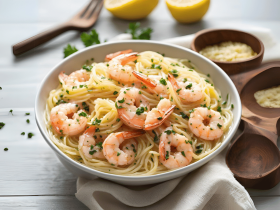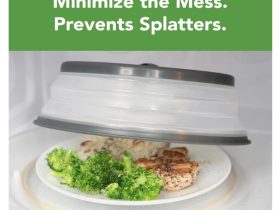Choosing the right microwave safe dishware is essential for both safety and convenience in the kitchen. With the rise in quick meal preparations, microwave safe plates and bowls have become indispensable. They are typically made from materials like glass, ceramic, or specially formulated plastic that can handle the microwave’s high-energy waves.
These dishes are marked with a microwave-safe symbol, usually found on the bottom, indicating they have been tested for safety in microwave ovens. Using the correct tableware, like microwave safe plates and bowls or oven safe plates and bowls, not only prevents damage to your microwave but also ensures that no harmful substances transfer to your food during heating.
As consumers become more health-conscious, the demand for reliable and durable microwave safe kitchenware continues to grow, making it a valuable addition to any modern kitchen

Credit: www.walmart.com
Materials Matter For Safe Plates And Bowls
Choosing the right plates and bowls for microwave use is important. The material they’re made from matters a lot. Some materials, like dishwasher safe plastic plates and bowls, can handle the heat, while others can’t. This guide will help you understand which materials are safe and which ones to avoid.
Ceramics Made Safe Plates And Bowls
Ceramics are a popular choice for microwave-safe dishes. They can handle high heat without breaking. But, not all ceramics are the same. Here are some key points:
- Porcelain and stoneware are great options. They are tough and can go in the microwave.
- Look for a microwave-safe label on the bottom. This label means it’s safe to use.
- Some ceramics have metallic paint. These should not go in the microwave. They can spark and cause a fire.
Always check before using a ceramic dish in the microwave. If unsure, it’s better to not use it.
Plastic Types For Safe Plates And Bowls
Plastics come in many types. Some are safe for the microwave, and some are not. Here’s what you need to know:
| Type | Is it Microwave Safe? |
| Polyethylene Terephthalate (PET) | Usually not |
| High-Density Polyethylene (HDPE) | Yes, but check for a label |
| Polycarbonate | No, it can release harmful chemicals |
Always look for a microwave-safe label on plastic dishes. This label means the product has been tested and is safe.
Glass Options For Safe Plates And Bowls
Glass is another good choice for the microwave. But, like with ceramics and plastics, not all glass is the same. Here are some tips:
- Borosilicate glass is very resistant to heat changes. It’s a top choice for microwave use.
- Soda-lime glass is common but can break with sudden temperature changes. Be careful with it.
- Always check if the glass has a microwave-safe label. This label is your best guide.
Choosing the right glass means your food heats up safely. And you won’t have to worry about your dishes breaking.
Labeling Signs
Understanding what plates and bowls can go in the microwave is important. Safe dishes, like dishwasher safe plates and bowls, keep our food and families safe. Look for special signs on dishes. These signs tell us if we can use them in the microwave. Let’s learn about these signs and what they mean.
Microwave Symbols
Kitchen items have symbols to show if they are microwave safe. These symbols look like a microwave or have some waves. It means we can use the dish in the microwave without worry.
Let’s explore these signs:
- Microwave Safe: A symbol with three wavy lines.
- Dishwasher Safe: A plate or glass with water drops.
- Food Safe: A symbol that looks like a wine glass and a fork.
Some dishes have a label that says ‘Microwave Safe’ or ‘Not for microwave use’. Always check the bottom of your dish. This will tell you if it’s safe or not.
Safety Certifications
Certifications make sure that dishes are safe for us. These certifications come from testing. Testing is done by experts. They check if dishes can handle the microwave’s heat.
Here are some common certifications:
| Certification | Description |
| FDA Approved | This means the dish is safe for food use. |
| UL Certified | This means the product has been tested for safety. |
| CE Marking | This is a European standard for safety. |
Look for these certifications when buying new dishes. They help you choose the best and safest options for your home.
Heat Distribution
Choosing the right plates and bowls for microwave use is important. They need to handle heat well. This ensures your food warms up properly. Some dishes can crack or break if they’re not microwave safe. Let’s explore how heat behaves in microwaves, focusing on even heating and hot spots.
Even Heating
Microwave safe dishes are designed to heat food evenly. This means no cold areas in your meal. The material matters a lot. Good plates and bowls spread the heat all around. Ceramic and glass are often good choices. They help make sure your food gets warm everywhere.
Here are some tips for even heating in microwaves:
- Use a microwave-safe cover to trap steam. This helps heat spread.
- Stir your food halfway through heating. It helps distribute heat.
- Arrange food evenly on the plate. It helps avoid cold spots.
Hot Spots
Hot spots are areas that get too hot. They can overcook parts of your food. Microwave safe dishes can help prevent this. But even with the right dishes, hot spots can happen. They occur when microwaves don’t spread out well.
Rotating plates or a turntable in your microwave helps. It moves the food around so all parts get heated. Avoid using metal or certain plastics. They can cause sparks or melt, leading to more hot spots. Here’s what to look for in safe dishes:
| Material | Hot Spot Prevention |
| Ceramic | Good at spreading heat |
| Glass | Heats evenly without absorbing microwaves |
| Plastic | Must be microwave safe to avoid melting |

Credit: www.amazon.com
Safety Tips
Many plates and bowls say they are safe for the microwave. But, it’s important to use them right to keep them safe. This means not letting them melt or crack. Here are some tips to help.
Avoiding Melting
Some dishes can melt in the microwave if not used properly. To stop this:
- Check labels on all dishes before using them.
- Use only microwave-safe dishes. They can handle the heat.
- Avoid plastics not marked as microwave safe. They can melt.
- Don’t overheat. Heat food in short times and check it.
- Spread food evenly on the plate. This helps it cook right.
Using dishes right keeps them from melting. Always follow what the maker says.
Preventing Cracks
Dishes can also crack. To stop this:
- Don’t change temperatures fast. Don’t move dishes from very hot to very cold places.
- Check for tiny cracks before using. They can make bigger cracks.
- Use a dish cover. It helps food cook evenly and stops spots that can crack.
- Don’t put empty dishes in the microwave. They need food or liquid to absorb the heat.
Being careful keeps your dishes safe. Always use them as they are meant to be used.
Best Practices
Everyone loves using microwaves for quick meals. But, using the right plates and bowls is key. We’ll talk about how to do it safely. This means picking microwave-safe options and knowing the best ways to use them. Let’s dive into some important tips and tricks.
Using Lids
Putting lids on dishes in the microwave is a smart move. Why? Because it helps in several ways. First, it keeps your microwave clean. No one likes cleaning up messes. Second, it helps food cook evenly. This means no cold spots in your meal. Lastly, it keeps moisture in, so food stays juicy and tasty. But, always use microwave-safe lids. Here are some tips:
- Use vented lids or leave a corner open. This lets steam escape.
- Avoid tight seals. They can cause pressure build-up.
- Choose glass or microwave-safe plastic lids. Not all materials are safe.
Remember, using the right lid makes a big difference!
Covering Food
Covering food in the microwave is another great tip. It does more than just keep the microwave clean. It helps food cook better. But, not all covers are the same. Here’s what to do:
- Paper towels work well for most foods. They’re easy to find.
- Wax paper is good for foods that need to stay moist.
- Microwave-safe plastic wrap is okay, but don’t let it touch the food.
Using these covers right makes meals tastier and safer. Always choose microwave-safe options. Enjoy your food knowing it’s done right!

Credit: www.walmart.com
Popular Brands
Understanding which plates and bowls can go into the microwave is key. It keeps us safe and our food warm. We often wonder about the best brands for these kitchen essentials. Let’s explore some popular ones that promise both safety and style.
Top Ceramic Brands
Ceramic dishes are loved for their durability and designs. Many top brands make microwave-safe options. These brands pay close attention to quality and safety. Below is a list of some leading ceramic brands known for their microwave-safe plates and bowls:
- Corelle – Known for lightweight and break-resistant dishes.
- Stoneware – Offers a handmade touch and unique glazes.
- Fiesta – Recognized for bright colors and a classic look.
These brands have passed tough tests. They ensure no harmful chemicals leak into food. It makes them perfect for family use. Children and adults alike can enjoy meals without worry. Each brand brings a special touch to the table, from Corelle’s sleek lines to Fiesta’s fun colors.
Leading Plastic Manufacturers
Not all plastics are safe for the microwave. But some manufacturers have mastered the art of safe plastic dinnerware. They use materials that can handle the heat. Here’s a look at some of the leading plastic manufacturers:
- Ziploc – Offers containers that are safe for microwaving.
- Rubbermaid – Known for their durable and heat-resistant products.
- Sistema – Creates clever designs with microwave-safe materials.
These brands focus on making products that are easy to use. They want families to feel safe heating food in their products. Kids can easily handle these lightweight dishes. They are also often easy to clean, which saves time. Parents trust these brands to provide safe and convenient options for everyday use.
Common Myths
Understanding which plates and bowls are safe for microwave use is important. There are many myths about what can and can’t go into microwaves. It’s time to uncover the truth about microwave safety.
Metal In Microwave
Many people believe that putting metal in a microwave will always cause sparks. This is not entirely true. Certain types of metal can cause problems. Here are the facts:
- Thin metals like aluminum foil are a no-go.
- Large metal pans can block microwaves, stopping food from heating.
- Some microwaves are designed to work with specific metal containers.
Sparks happen when metal pieces are too close together or with edges. They act like antennas, leading to electric arcs. It’s best to use containers marked as ‘microwave-safe’ to avoid any danger.
Plastic Safety Misconceptions
Plastics in microwaves are a hot topic. Not all plastics are the same. Some are safe, while others can harm your health. Here’s what you should know:
- Check for a microwave-safe label on your plasticware. This means it’s tested for microwave use.
- Some plastics release chemicals when heated. Always use containers marked safe.
- Plastic wraps need a little space. Don’t let them touch your food while microwaving.
Containers marked with recycle codes 3, 6, and 7 might contain chemicals like BPA or phthalates. These can leak into food. Containers with code 5 are typically safer. Always check for a microwave-safe stamp.
Cleaning Methods
Microwave safe plates and bowls are great for everyday use. They make reheating food easy. But, keeping them clean is important. There are two main ways to clean them: in the dishwasher or by hand washing. Each method has its own steps to follow.
Dishwasher Safe
Many microwave safe plates and bowls can go in the dishwasher. This makes cleaning easy. Before putting them in, scrape off any leftover food. Use a gentle dishwasher detergent. Place them on the top rack if they are plastic. Glass or ceramic can go on any rack. Avoid setting the temperature too high. Hot temperatures can harm some dishes. After the cycle, check if they are dry. If not, dry them with a soft cloth. This keeps water spots away. Here is a simple guide:
| Material | Placement in Dishwasher | Detergent Type | Drying |
| Plastic | Top Rack | Gentle | Dry with Cloth |
| Glass/Ceramic | Any Rack | Gentle | Dry with Cloth |
Hand Washing Tips
Hand washing is another way to clean your dishes. Use warm water and mild soap. A soft sponge works best. It won’t scratch your dishes. Rinse them with clean water. Then, dry them right away to avoid water marks. Here are some steps:
- Remove leftover food from the dishes.
- Fill the sink with warm water and add mild soap.
- Wash each dish with a soft sponge.
- Rinse dishes under clean running water.
- Dry immediately with a soft cloth or towel.
This method keeps your dishes looking new. It also prevents damage from harsh scrubbers.
Frequently Asked Questions
Microwave-safe plates can be made from glass, ceramic, certain plastics, and even bamboo. It’s crucial to check for a microwave-safe label before use, as not all materials within these categories are suitable for microwave heating.
Look for a microwave-safe symbol on the bottom of the bowl, which typically resembles a microwave or waves. Absence of this label, especially on plastic bowls, suggests it may not be safe for microwaving.
Microwave-safe dishware is designed to withstand microwave heat without damage. However, repeated use over time might lead to wear or thermal stress, so regular inspection for any signs of damage is recommended.
Not all glass dishes are safe for microwaves. Borosilicate glass and tempered glass are generally microwave safe. Regular glass can crack or shatter, so it’s important to confirm if it’s specifically labeled as microwave safe.






















Leave a Reply